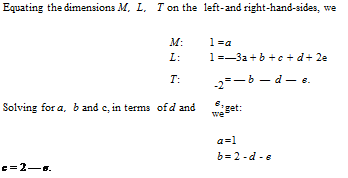Aerodynamic Force
Aerodynamic force acting on an aircraft is the force due to the pressure distribution around it, caused by the motion of the aircraft. Thus, the gravity does not enter into the specification of aerodynamic force. Assuming the motion of the aircraft to be steady without rotation, the aerodynamic force on the wing or on the complete aircraft may be expected to depend on the forward speed V, air density p, speed of sound a and kinematic viscosity v, of the environment in which it is flying, and the total length l of the aircraft.
If the air is assumed to be incompressible and inviscid, we have the density p = constant and the viscosity coefficient p = 0. Therefore, the speed of sound becomes:
a
Assuming the flow over the aircraft to be isentropic, we have:
— = constant.
PY
Differentiating with respect to p, we have:
— = (constant) y P(y 1. dp
P
Now, replacing the “constant” with —-, we get:
dP P (–1)
t = ~y yp(y )
dp pY
YP
p
Substituting this, we get the speed of sound as:
a
For incompressible flow with dp = 0, we have the speed of sound as:
a = <x
For inviscid fluid, the kinematic viscosity becomes:
M n v = — = 0.
P
Therefore, for incompressible flows, the aerodynamic force Fad does not depend on the speed of sound a and kinematic viscosity v. Thus, Fad can be assumed to depend only on p, V and l. The Fad would be given by a formula such as:
![]() Fad = 2 kpaVblc,
Fad = 2 kpaVblc,
![]()
by dimensional theory as follows.
In terms of the fundamental dimensions of mass (M), length (L) and time (T), we can express Equation (1.1) as:
Equating the dimensions M, L, T on the left-hand-side and right-hand-side, we get:
M : 1 = a
L : 1 = -3a + b + c
T : – 2 = – b.
Solving for a, b and c, we get:
a = 1, b = 2, c = 2.
Substituting for a, b, c into Equation (1.1), we get:
![]() Fad = 2 kpV Чг.
Fad = 2 kpV Чг.
This is valid only for steady incompressible and inviscid flows. If we wish to account for compressibility and viscosity, a and v should be included in Equation (1.1) and expressed as:
![]() Fad = ^2 1 к paVblc
Fad = ^2 1 к paVblc
where – ki is a dimensionless number, and each side must have the dimension of force. Here ^ denotes the sum of all allowable terms. In terms of basic dimensions M, L and T, Equation (1.3) becomes:
ML (Ma(Lb r (Ld ( L2 ‘
~r2 = v) r) l t) Y.

 |
Thus, Equation (1.3) becomes:
Fad = X) 2hpV2—d—el2—ei
or
![]() X—^ 1 22 ( V N — ( Vl
X—^ 1 22 ( V N — ( Vl
fad = £ 2- –
The ratio (V/a) is called the Mach number M, which is essentially a dimensionless speed. Mach number is the ratio oflocal Bow speed to the local speed of sound or the ratio of inertial force to elastic force. It is a measure of compressibility. For an incompressible fluid, M = 0.
The dimensionless group (Vl/v) is called the Reynolds number Re. Reynolds number is the ratio of inertial force to viscous force. For an inviscid fluid Re = to. For air, the kinematic viscosity v is small and Re is large unless Vl is small.
Thus, Equation (1.4) becomes:
Fad = 1 pV21253 kxM—d Re—e
= 1 pV2Sf(M, Re),
![]() where l2 has been replaced by f (M, Re) is a function, whose independent of physical units.
where l2 has been replaced by f (M, Re) is a function, whose independent of physical units.
The dimensionless number:
is called the (dimensionless) coefficient of the aerodynamic force Fad. The effect of compressibility can usually be neglected if M < 0.3, and the flow is termed incompressible. Thus, for an incompressible flow, the aerodynamic force coefficient is a function of Reynolds number only. That is:
CFad = f (Re).
At this stage, we may wonder about the definition of incompressible flow. The mathematical definition of incompressible flow is that “it is a flow with Mach number zero.” But it is obvious that, for M = 0, the flow velocity is zero, and hence there is no flow. But mathematics, as an abstract science, stipulates the limit of M = 0, with the sole idea of rendering the density to become invariant. But when V = 0, engineering science will declare it as a stagnant field and not as a flow field. Therefore, the engineering definition of incompressible flow is drastically different from the mathematical definition. From an engineering point of view, when the density change associated with V is insignificant the flow can be termed incompressible. Also, for engineering applications, any change less than 5% is usually regarded as insignificant. With this consideration, any flow with density change less than 5% can be called incompressible. For air flow at standard sea level conditions (p = 101325 Pa and T = 288 K), 5% density change corresponds to M = 0.3 [1]. Therefore, flows with Mach number less than 0.3 are regarded as incompressible flows and the density p0 corresponding to the stagnation state is taken as the density of an incompressible flow.











